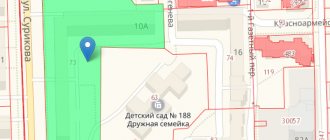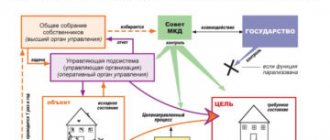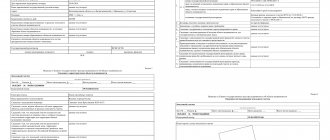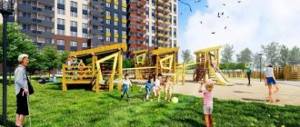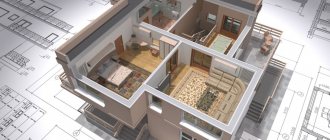Adjacent territory (PT) is not a speculative concept, but quite specific and legally significant. This is the common property of all owners of apartments and houses. And you need to be able to use this property. The materials posted on our website are devoted to various aspects of interaction between individuals and legal entities in connection with determining the size and status, as well as the use of the local area. With this review, we hope to make it easier for you to find the information you need.
Legal problems
- determining the size and boundaries of the PT;
- nature of use;
- management features.
The fact is that common property belongs to everyone. This means that while a person has the right to use and dispose of property, he cannot do anything alone. All decisions regarding PT are made only by a majority vote at the general meeting.
This is how the peculiarities of managing local areas manifest themselves. At the general meeting, residents decide on the placement of new facilities not included in the project, the allocation of plots for parking, landscaping, and recreational areas.
The main legal problem is determining the boundaries and area of the local area. The fact is that such territories were not allocated for houses of old construction. Yes, some buildings and courtyards did not have, there were only streets and areas like a well. Since buildings built before the nineties of the twentieth century were in state ownership, issues of development of adjacent areas were resolved at the level of local authorities.
For this reason, there are many buildings in cities that formally do not have adjacent areas. Sometimes there is simply nowhere to form them. At the same time, there is a method for calculating PT in accordance with the total area of the apartments of a given building. In order for a house to have its own official local area, property owners need to hold a general meeting (the quorum is two-thirds of the total number of owners), make a decision and contact the municipal authorities with a request to carry out land management work.
Land managers must not only determine the area of the PT, but also mark it on the ground. This will be useful for further actions on the use of land owned by the owners of the apartments of this building. After carrying out the work and receiving the technical plan, a package of documents is submitted to the Rosreestr authorities. If the applicants are denied registration of the PT as part of the property, then such a decision can be appealed in court.
Rules for placing objects
Everything that is located in the local area is a consequence of the implementation of the project, the decision of the residents of the house, or the illegal actions of people who want to benefit. After the house is built and put into operation, the so-called landscaping is carried out. The objects provided for by the project must be handed over along with the house. Everything else is finalized by the owners.
The biggest problem in the courtyards of urban apartment buildings is parking. Older houses were not designed for a large number of cars. Moreover, historical buildings were generally erected without taking into account the availability of personal transport. For this reason, when managing local areas, the organization of parking spaces is of great importance.
Who serves the territory
The fact that the adjacent territory belongs to all apartment owners does not mean that they all service it at once or in turn, although this is also possible. By decision of the general meeting, apartment owners choose a management company that not only ensures the viability of the house, but also maintains the surrounding area in proper order.
The scope of work depends on the agreement between the residents and the management company. However, usually such an organization carries out work on:
- cleaning the area;
- arrangement of recreational areas, including children's playgrounds;
- the formation of areas with green spaces;
- repairing roads in the yard;
- care of all PT facilities.
So, when choosing a management company and concluding an agreement with it, residents need to carefully consider all the points of mutual obligations.
If the local area is not allocated or some of the objects are, by force of circumstances, owned by the municipality or some department, then the general meeting or initiative group will have to interact with the management of the institutions, forcing them to take the necessary actions. If there is no provision in the agreement for maintenance, for example, of the road and sidewalks, the issue of a one-time event to pay for road repair work at the expense of the residents of the house will have to be put on the agenda of the general meeting.
This is important to know: How to get out of SNT if you own land: procedure and consequences
You will have to equip the yard with video cameras yourself. To do this, you can enter into an agreement with an organization working on the “safe yard” project. The agreement can be concluded either with an individual or with the owners of several apartments. The advantages of this project are that with the help of a video camera placement system it is possible to cover almost the entire local area with round-the-clock surveillance.
Standards for cleaning the territory for a janitor according to the law
Cleaning of the territory of households is carried out in accordance with the standards that are established, including for janitors. Such issues are regulated by the Resolution of the Ministry of Labor and the Order of the State Construction Committee - the documents are discussed below.
It is important to understand that the standards in each case are established by a specific organization, but they cannot contradict the norms of federal legislation. The employee must find out such information before signing an employment contract. As a rule, the table of norms is given:
10 Jun 2021 lawurist7 1571
Share this post
- Related Posts
- Extortion for moral suffering
- Why Should Veterans' Payments Be Returned If You Changed Your Place of Residence?
- UIS Pension Calculator 2021
- Stoker Refers to Harmful Working Conditions
How to organize parking
Usually, the entire parking infrastructure already exists in the PT of new houses. However, this is often not enough. For this reason, the general meeting of residents may develop additional measures for the organization of special areas intended for parking.
It is necessary to distinguish between the concepts of parking and parking. The first option involves short-term placement of the car in an unguarded area.
In this case, the safety of the property must be ensured by its owner. The second option involves the formation of an isolated area where cars are under the supervision of special personnel. In this case, the agency servicing the parking lot is responsible for the safety of the property. As a rule, parking lots are not installed in courtyards, because in this case it is impossible to ensure compliance with the sanitary standards required for such facilities.
Violations of parking rules in local areas most often manifest themselves in the fact that motorists place their cars on lawns, sidewalks or near apartment windows. For such violations, vehicle owners are punished by a fine, the amount of which is determined at the regional level. In this case, of course, you need to contact the State Traffic Safety Inspectorate for help.
Many people treat the local area as an abstraction that has nothing to do with the lives of the owners of specific apartments. This feeling persists as long as the courtyard of the high-rise building is pleasing to the eye, and the actions of people in it do not create problems for the residents of the building. People remember that this is their property when life in apartments is complicated due to the poor condition of the courtyards. At this point, knowledge of the legal intricacies of managing common property will be required. We hope that the materials posted on our website will be useful not only for getting out of extreme situations, but also for creating more comfortable conditions.
What do the definitions mean - residential area - and - courtyard area
Residential area and courtyard area are not always identical concepts. The boundaries of a residential zone are delineated by road signs, and there is no definition of “yard territory” in any legislative acts at all. However, signs establishing a residential zone in cities are extremely rare, so most often such zones are understood as courtyard areas.
This is interesting: Diamond Autumn Pension Application Form
Most drivers are not aware that a yard and a residential area have some significant differences, and there are rules for each of these concepts, so it is worthwhile to firmly understand the differences between these definitions. The traffic rules in paragraph 17.4 state that all paragraphs of this section, called “Traffic in residential areas,” are fully transferred to the wording “yard areas.”
What is the local area of an apartment building?
Housing legislation gives the following definition of the concept of “house area” - this is the land plot where the house itself and various elements of improvement and/or landscaping are located.
The courtyard area should provide the possibility of free access to the residential building itself and the passage of utility and emergency services vehicles.
Transformer booths, boiler houses and gas distribution stations, playgrounds, football and basketball fields, walking paths and parking lots are also included in the site adjacent to the urban apartment building.
The dimensions and outlines of the local area are not taken arbitrarily. They are determined by regulations - town planning regulations and SNIPs.
Even when designing a future residential complex, the developer makes calculations using various standards. The height of the house, the density and number of storeys of existing surrounding buildings, the boundaries of existing neighboring plots and other factors are taken into account.
In the most unfavorable case, the size of the local area will be only slightly wider than the area occupied by the house itself. But, as a rule, its size is much larger.
Traffic rules for residential areas and courtyards
Also, parking and parking of trucks with a total weight exceeding 3.5 tons is prohibited in courtyard areas; these vehicles are automatically classified as category C vehicles. To be fair, it is worth noting that for their parking in yards there are or should be special places with markings and signs. Moreover, placing cars on lawns is prohibited; a fine is also provided for this; its amount is regulated by the Law of the Russian Federation and depending on the region, but it is measured in thousands of rubles.
This is interesting: Why is there no Light in Saratov Zavodskoy
However, the courtyard area may be included in the area of the residential area, in turn, the residential area can also be a certain part of the courtyard area. Apparently, this is why in the traffic rules, in section 17, unifying rules for both territories and zones were introduced, although this did not make the difference any clearer. But the remaining sections of the traffic rules cannot be summed up under a single line; they relate only to a certain territory, which is directly discussed in a separate paragraph of the rules.
Rules for landscaping the local area
SNIPs set standards not only for the size of the plot near the house.
These documents also contain a comprehensive list of objects that can be placed in the yard:
- green spaces in the form of flower beds, slides, lawns, ornamental trees and shrubs;
- transport passages and paths for pedestrian residents;
- playgrounds for children of different ages and active games;
- relaxation areas for adults;
- areas and places for walking and training dogs;
- domestic buildings and auxiliary structures.
Prohibited objects include retail outlets and catering establishments, car workshops and car washes, any production facilities, and paid parking.
Who owns the adjacent territory of an apartment building?
According to Art. 35 of the Housing Code, all owners of both residential apartments and non-residential premises are considered the owners of the common local area.
But such a right does not arise automatically. First, it is necessary to carry out privatization, otherwise the site under such a house will remain municipal.
Ownership of the land under a multi-storey building is joint. This means that each apartment owner owns a certain part of the plot.
However, the law does not allow it to be isolated to be used at one’s own discretion or to dispose of its fate. Such property can be used and disposed of only together, making decisions exclusively at a meeting of owners.
Residential zone" - which means traffic rules
What is a “residential zone” (hereinafter referred to as ZZ)? The traffic rules do not define the concept of life safety in its pure form. But the driver can independently – within the framework of interpretation of the law – give a concept to this section. Thus, clause 17.1 of the traffic rules states that a residential zone is a territory that has a “Residential zone” sign (5.21) at its entrance, and a “End of residential zone” sign (5.22) at its exits.
The motive here is clear: an inexperienced driver (not even a driver yet, according to traffic regulations) in a residential area may not orient himself in time and cause harm to both pedestrians and vehicles parked closely in courtyard parking lots.
Registration of the local area as collective property
Land surveying is the first step for residents to privatize their local area. And, strictly speaking, the only one.
Back in 2010, the Constitutional Court recognized a special procedure for transferring ownership of land under any multi-apartment building to apartment owners.
Unlike the privatization of lands for other purposes, after a new land plot is allocated and registered in the cadastral register by an act of municipal authorities or at the request of home owners, the right to it automatically passes to the owners of the house.
Obtaining land ownership has a number of undeniable advantages:
- by decision of the general meeting, it can be used for profit - rented out;
- the city cannot build anything on such a site without the consent of the legal owners;
- If it is necessary to use the local area for public needs, the municipality can only purchase the site or part of it.
This is important to know: How to find out if land is owned
In addition, you will need to pay land tax annually. The amount will have to be calculated independently and then distributed proportionally among all owners. The larger the area of the occupied apartment or commercial premises, the higher the tax will be.
Maintenance of the local area of an apartment building
The concept of “maintenance” includes the following work in the local area:
- landscaping and maintaining plantings clean and tidy;
- arrangement of waste collection sites, their timely cleaning and maintenance;
- repair and painting of playgrounds, benches, fences and other landscaping elements;
- cleaning the area adjacent to the house from snow and debris, draining melt and rain water;
- organization and maintenance of pedestrian paths, their cleaning and anti-slip treatment;
- parking equipment and maintenance, etc.
Landscaping of courtyard areas - duties and responsibilities
- constant cleaning of the entire territory;
- unimpeded access to inspection wells of water supply sources and other utility networks;
- collection and removal of solid waste of any category;
- landscaping;
- care of green spaces;
- repair of small architectural forms;
- accessibility of access roads for all types of transport along the entire perimeter of the house;
- separation of pedestrian areas from the roadway;
- improvement of recreation areas, including children's playgrounds;
- availability of an optimal number of parking spaces.
Their owners are responsible for the condition of any territories. While everything is clear with private households, the area of responsibility of apartment buildings is not always clear. Determining the boundaries of the local area is very simple; just look at the cadastral passport for the land plot allocated for the construction of this house.
Cleaning the local area of an apartment building
Residents are obliged to clean the territory belonging to the house. However, it is not at all necessary to do this yourself, although it is possible by drawing up a work schedule.
But most often the management company is responsible for cleaning. To do this, its staff has the required number of employees (janitors).
If a homeowners association is organized in the house, then the contract for cleaning the yard is concluded with a specialized commercial company.
Responsibility for the quality of cleaning and compliance of the sanitary condition of the local area with current standards lies with the owner.
Parking arrangement procedure
The creation of surface parking is one of the permitted types of use of the area around an apartment building. For their arrangement, areas with a sufficiently durable coating are used.
Parking can be marked according to the number of apartments, with a personal space assigned to each of the owners. This decision is made at the general meeting.
When placing parking, the following points must be taken into account:
- it should not interfere with access to entrances or the passage of emergency vehicles;
- it is impossible to increase the parking area at the expense of areas occupied by green spaces;
- the minimum distance from the parking lot to a residential building is 10 m, and if it is designed for a large number of cars, then all of 15.
Car parking in the courtyards of residential buildings
Expert opinion
Tarasov Dmitry Timofeevich
Legal consultant with 7 years of experience. Specializes in the field of civil law. Member of the Bar Association.
Let's consider the points of the rules regulating parking in the courtyards of residential buildings . Naturally, the same traffic rules apply in courtyard areas as on a regular road, but there are some peculiarities:
- Parking with the engine running is prohibited.
- Parking of trucks is prohibited.
Parking with the engine running is prohibited in residential areas and courtyards . The article “Differences between the concepts of stopping and parking” discusses in detail the signs of stopping.
Here I just want to remind you that if the vehicle does not move for more than 5 minutes and there are no passengers boarding or cargo unloading, then it is parking.
Please note that if in the cold season the driver warms up the car for 5 minutes or more, then he violates the requirements of the rules and may receive a traffic police fine, which will be discussed below.
Parking rules in yards prohibit the parking of trucks with a permissible maximum weight of more than 3.5 tons, i.e. cars of category C, outside specially designated areas (marked by road signs or markings).
Please note that it is also prohibited to park a car in the courtyard area or on the lawn. The fine for parking on the lawn depends on the region of the Russian Federation and can be quite large (several thousand rubles).
Is it possible to fence the local area?
The desire of apartment owners in a building to make their yard closed to outsiders is completely legal.
But enclosing the local area with a fence and restricting passage and travel through it is possible only if two conditions are met:
- the plot on which the house stands and the yard is located is registered as common property (privatized);
- The decision to install the fence was made by a majority vote at the general meeting and this fact is reflected in the minutes.
It is also possible to install various types of fences around a non-privatized plot. But only in such a way that they do not interfere with the free passage of pedestrians and the passage of special vehicles.
Residents of an apartment building decide for themselves how to use the courtyard area that belongs to them.
Intervention by municipal authorities is possible only if there is a violation of land or town planning legislation, as well as a violation of the rights of third parties.
What do the definitions mean - residential area - and - courtyard area
However, the concepts themselves are not the same and these are different areas, although people live in both. There are even different visual signs to differentiate the traffic rules, which means that the residential area is different from the courtyard area. As for the concept of “yard territory”, there is simply no clear formulation and explanation in the traffic rules.
Residential or courtyard areas are not intended for the transit of vehicles. From the moment you entered the coverage area of sign 5.21 or any courtyard area until the moment you left (sign 5.22), you are required to follow the traffic rules established by the traffic police.
What is a local area
First you need to find out what is called the local area. So, the local area is the area that is adjacent to a multi-story building. This may include:
- Children's and sports grounds.
- Football fields and hockey rinks.
- Parking and garages.
By law, the area around the high-rise building belongs to the residents of the building. That is, they are the ones who own this land under the right of common ownership. The boundaries of the local area of an apartment building are determined when registering ownership rights. You can view them in the extract for the land plot. In the same document you can see other buildings that need to be maintained. These may include:
- Thermal and transformer substations.
- Means for improvement and landscaping of the yard.
So, the local area is the area that is located directly under a multi-story building and in its surroundings. Now we need to figure out who should care for this territory.
Who should clean the local area of an apartment building?
Several years ago, amendments were made to the Housing Code that related to the maintenance of the local area of an apartment building. The legislator noted that land owners . They could only be the owners of apartments in an apartment building. That is, payments for the maintenance of the local area were included in the payment document. This amount depends on the area of the apartment in an apartment building. The larger the area, the more you need to pay.
So, according to the law, residents of an apartment building must monitor the adjacent territory. They pay for the maintenance, use of the site, and take care of it. In other words, all the work that is carried out on the territory of an apartment building is the merit of the residents.
In order to track maintenance payments , management companies are created or these responsibilities are transferred to the HOA. They also carry out all the necessary work to improve the territory.
But what to do if the land plot under the high-rise building is not the property of the residents, does it become their use? Here it is necessary to clarify that, by law, the adjacent land must be transferred to residents on the right of common ownership. But no one will do this automatically. You must independently go through the entire procedure and rules for registering a land plot under a high-rise building as a common shared property. Otherwise, the adjacent site is the property of the local administration . She is the one who takes care of the yard of the house.
So, the residents of the house must take care of the area around the house if the area is registered as shared ownership. Otherwise, this is handled by the local administration. It turns out that if the land plot is not registered as shared ownership, then you do not need to pay for it. This is how the law can be interpreted. But currently, residents pay for the use of the area near the house, but the land plot does not belong to them.
This is important to know: Land tax for legal entities in 2021
Privatization of the local area in an apartment building: what are the rules?
To register the territory as shared ownership, you can create a condominium association. This is a legal entity that is created by the residents of the house to manage the house. The organization helps improve the quality of housing and communal services and regulates the proper use of common property.
What is needed to ownership of a land plot
- Hold a general meeting of all apartment owners in an apartment building.
- Collect signatures for consent to privatize the local area.
- If you have a technical specification and permission to allocate land, then you need to contact a land management company, where you need to collect a package of documents: a certificate of registration of a legal entity, a technical passport for the property, a charter, a plan of the boundaries of the local area.
- After all documents and the application have been collected and handed over to the employee, the registration process will begin. For this purpose, a project will be developed to determine the boundaries of the site. The land plot will be allocated according to it.
- At the city meeting, a decision will be made to transfer the land plot into ownership to the residents of the apartment building.
All that remains is to register the right to use the site. This is done in the Unified Register.
After registration of ownership of the site, no one will be able to build or demolish any buildings on the territory without your consent.
Is it necessary to register a plot of land as a property?
Privatization of the territory near a high-rise building has positive and negative aspects. Advantages of registering a plot as shared ownership:
- Without the consent of the owners, it will not be possible to build buildings on the site or demolish buildings.
- Owners of a local area can rent it out and receive money from it.
- Registration is free.
- The adjacent area is used at the discretion of the residents of the apartment building.
Disadvantages of privatizing a land plot under a high-rise building into common ownership:
- A small number of buildings are allowed on the site. These could be children's or sports grounds, garages.
- Residents of an apartment building will be required to maintain the site and improve it at their own expense.
- According to the Housing Code, owners of apartment buildings are required to pay for the maintenance of the site. The payment amount will depend on the area of the apartment. The larger the apartment, the more the owner will have to rent to maintain the local area.
So, there are advantages to registering a plot of land under a high-rise building as your own, but there are also negative aspects. The disadvantages relate to the financial side of the issue. If you register the local area as your property, you will have to not only monitor its well-being, but also pay a tax for the land plot.
Adjacent territory of an apartment building, standards
If you nevertheless decide to register the property of a local area, you need to know what the rules are for calculating the boundaries of this area. To calculate boundaries there is a formula that includes the following indicators:
- Living space in an apartment building.
- Specific unit of land share per square meter of housing. To calculate it, you need to take the parameters of construction regulations (SNiP). These indicators vary. It all depends on what year the house was put into operation.
To calculate the boundaries, you need to multiply these two indicators. In addition, it is necessary to take into account the roads that are located near the house, the density of buildings on the site, and how many floors there are in the house.
It is worth noting: lawyers use more complex formulas to calculate the boundaries of a local area. But for ordinary people this formula will be enough. This way you will roughly know what the boundaries of the adjacent area of your apartment building will be.
How to install a fence on a site near a high-rise building
In every house there lives a person who is trying to improve the courtyard of a high-rise building. To ensure that these efforts are not in vain, the site must be fenced. But do not confuse a fence with a fence. Fencing for private areas:
- Lawn - trees whose height does not exceed a meter. Such fencing is rarely used in our country. After all, trees require attention and constant care.
- Decor – a fence made of brick, wood, metal. You can also use corrugated sheets.
- Barrier . This is not partial fencing.
Non-permanent fencing can also be installed. For example, near dangerous areas.
It is worth noting: before fencing off an area from hooligans, these actions must be coordinated with the competent authorities.
The yard area is
17.2. In a residential area, the through traffic of motor vehicles, practice driving, parking with the engine running, as well as parking of trucks with a permissible maximum weight of more than 3.5 tons outside specially designated and marked areas with signs and (or) markings is prohibited.
17.1. In a residential area, that is, in an area whose entrances and exits are marked with signs 5.21 and 5.22 , pedestrian movement is permitted both on sidewalks and on the roadway. In residential areas, pedestrians have the right of way, but they must not unreasonably interfere with vehicular traffic.
